Customer experience is a top concern for modern and forward-thinking businesses. User experience designers’ skills are therefore in great demand. If you are to sustain growth and keep your competitive edge this year, you need a certain set of skills.
Below are 12 UX designer skills you should be able to master:
1. Communication Skills
UX design is all about teamwork. It’s not possible to solve the problem alone. Designers should strive to effectively communicate with their teams to ensure coordination of all the activities involved.
2. Negotiation Skills
Your communication skills should be blended with the ability to negotiate. Designers need to possess the ability to convince team members on a particular approach. Negotiation is important, especially when team members have different ideas.
3. Empathy and Curiosity
This is perhaps one of the most useful UX designer skills you need. Empathy is the ability to understand the other person’s experience from their point of view. Curiosity on its part is associated with analytical thinking, investigation, exploration and learning. UX design defines the way people interact and relate with their world.
Empathy in conjunction with curiosity can, therefore, be maximized to achieve the greatest user satisfaction. Unlike empathy, which is concerned with giving people what they want, curiosity takes you to deeper depths of understanding the reasons.
4. Collaboration Skills
As a UX designer, you need to collaborate skillfully with your team, stakeholders and any other person, no matter how difficult they might be. The driving force of this skill is a genuine desire to understand the other person and the ability to clearly express your point of view while keeping the lines of communication open. This ensures a shared understanding.
5. Logic and Reasoning
As a UX designer, you must have the capacity to arrive at solutions by logically synthesizing, comparing and contrasting the available options. Through this elaborate process, generate the ideas, design, test and prototype. Reason, on the other hand, eliminates circular arguments by creating a scenario of learning from failures. A UX designer does not succeed by just dreaming, but by using his/her rational abilities to understand the current situation and how to handle it.
6. The Ability to Hear and Accept Feedback
Get feedback early. It helps create an efficient design process and a better end product. Feedback from customers has the effect of broadening your designing lenses. Your ability to receive the most critical of feedbacks positively is a valuable skill in UX designing.
7. Storytelling and Presentation
To be a good UX designer, you need to be skillful in telling stories. Every design is a story. It’s a summary of many inputs from different quarters, to produce a final product with the best user experience. A good storyteller is able to persuade, properly frame the problem, the strategy and vision. A concept can only be approved for development if properly packaged. You need the skill to present a coherent argument full of facts, laced with emotions and compelling graphics. This will make a dominant UX designer. Crown the experience with a great presentation.
8. Visualization
To be an efficient UX designer, you must visualize data and information. Simplify it, so it’s functional and easy to the eye. Do not complicate UX design as is the practice of many. The more user-friendly your design is, the closer you are to your goal of empowering users with the ability to complete a ‘real life’ action. Remember, a mobile application is designed to enable more enjoyable and easy browsing.
9. Analytics and Research
UX designers need to acquire a relevant analytical focus. This refers to thinking through the impact the designs will have on business. Previous user research will come in handy in improving the initial idea before you finish designing. Develop clear parameters in your research, so you are able to get your desired end.
10. Wire Framing and Prototyping
Wireframing is the stage where an idea is shaped into a tangible thing. The golden rule is to keep it simple and easy to understand. Effectively do this in a way that makes sense through pen and paper. The idea is to put it down in a manner that can help you review your work to meets your expectations.
11. Psychology and Behavioral Trends
Reading on the domain of psychology and behavioral science can be very helpful to UX designers. Understanding actual principles in behavioral science will enable the designer to produce a final product that will give the user the ultimate experience.
12. Business Acumen
This is a critical UX designer skill. A successful UX designer must connect design to the desired business outcome. Having such skills will thrust you into the core of the organization’s leadership. You don’t just give technical services, you are also involved in decision making.
User experience (UX) design skills are increasingly becoming indispensable. As one of these designers, you need to stay on top of the current trends in the industry. The skills presented here are both contemporary and useful. Apply all of these UX designer skills to stay on top of your game.

